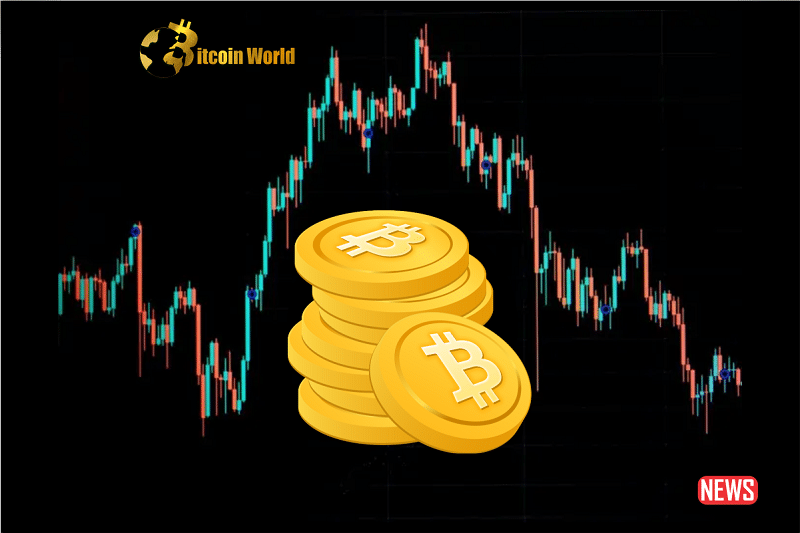Bitcoin’s journey is rarely a straight line to the moon, and the past few days have been a stark reminder of that. After briefly basking in the glow of Grayscale’s legal victory, BTC took a tumble, shedding over 4% in just 24 hours. So, what gives? Let’s dive into the factors behind this retracement and see if we can decode the crypto tea leaves.
Bitcoin’s Price Plunge: A Quick Recap
Currently hovering around $26,202, Bitcoin has retreated to the lower end of its recent trading range. While market volatility is nothing new in the crypto world, this particular dip warrants a closer look. It seems the big players, often referred to as ‘whales,’ might have been stirring the pot.
Whales in Action: Are They Behind the Bitcoin Dip?
Think of Bitcoin whales as the financial titans of the crypto world. Their massive holdings mean their trades can significantly impact market prices. Recent on-chain data suggests their actions played a key role in this latest pullback.
- The 10,000+ BTC Club: Interestingly, wallets holding over 10,000 BTC (we’ll call them the ‘mega-whales’) started accumulating Bitcoin around August 27th. However, this buying spree was short-lived, as they shifted to a selling stance just 24 hours later. Talk about a quick change of heart!
- The 1,000 – 10,000 BTC Group: Simultaneously, addresses holding between 1,000 and 10,000 BTC also began accumulating on August 27th. But like their mega-whale counterparts, their accumulation was brief.
This synchronized buying and selling activity raises eyebrows. Could this be a case of market manipulation?
Market Manipulation or Just Savvy Trading? The Whale Enigma
Did Whales Set a Bull Trap?
The timing of these whale movements suggests a potential ‘bull trap.’ Here’s how it works:
- Pump the Price: Whales buy a significant amount of Bitcoin, creating artificial demand and driving the price up.
- Lure the Crowd: This price increase attracts retail investors and those using leverage, creating a sense of bullish momentum.
- The Dump: Once enough buyers are in the market, whales sell off their holdings, causing a sharp price drop and liquidating leveraged positions.
The end of August saw a surge in bullish sentiment, with increased open interest and a higher appetite for leverage. This created the perfect environment for a potential whale-orchestrated shakedown. On August 29th, as predicted, the estimated leverage ratio and open interest decreased, coinciding with Bitcoin’s price decline.
Example of Potential Whale Activity
Imagine a scenario where a large whale buys a substantial amount of BTC, pushing the price up by a few percentage points. This attracts smaller investors who fear missing out (FOMO). Once the price reaches a certain level, the whale sells their holdings, taking profits and causing a rapid price decline, leaving the latecomers with losses.
The SEC’s Curveball: Bitcoin ETF Decisions Delayed
Adding another layer to the Bitcoin narrative, the U.S. Securities and Exchange Commission (SEC) announced on August 31st that they would be delaying decisions on several spot Bitcoin ETF applications. This news dampened the spirits of many investors, from institutions to retail traders, who were hoping for a positive catalyst to fuel a bullish run.
Impact of the SEC Delay:
- Institutional Investors: Many institutional investors are waiting for SEC approval of a Bitcoin ETF before allocating significant capital to the asset. The delay pushes back their potential entry point.
- Whale Sentiment: Even whales might have been anticipating the ETF approval as a major price driver. The delay could have contributed to their decision to take profits.
- Retail Investors: The delay introduces more uncertainty into the market, potentially leading to a more cautious approach from retail investors.
Whale Behavior: Re-accumulation After the Dip?
Here’s a silver lining: historically, whales have shown a tendency to increase their Bitcoin holdings after significant price drops. This suggests a longer-term bullish outlook for some of the biggest players in the game. However, it’s crucial to remember that past behavior doesn’t guarantee future outcomes.
Key Observation: Lower Liquidation Levels
Despite the recent price drop, the level of liquidations was notably lower compared to the significant liquidation event in mid-August. This could indicate that whales are becoming more strategic in their short-term trading or that they are indeed shifting towards a longer-term investment horizon.
Navigating the Bitcoin Seas: What Can We Learn?
The recent Bitcoin price action highlights the complex interplay of factors influencing the cryptocurrency market. Whale activity, market sentiment, and regulatory news all play a significant role in shaping price movements.
Actionable Insights for Traders:
- Stay Informed: Keep a close eye on on-chain metrics and news related to whale activity.
- Manage Risk: Be cautious with leverage, especially during periods of high volatility.
- Long-Term Perspective: Consider the long-term potential of Bitcoin rather than solely focusing on short-term fluctuations.
- Diversify: Don’t put all your eggs in one basket. Diversifying your portfolio can help mitigate risk.
The Future of Bitcoin: A Whale of a Tale Continues
The cryptocurrency market remains a dynamic and often unpredictable space. The influence of whales, coupled with regulatory developments and ever-shifting market sentiment, creates a fascinating landscape for traders and enthusiasts alike. While short-term price swings can be unsettling, understanding the underlying dynamics, including the potential actions of large holders, can provide valuable context. As the Bitcoin story unfolds, vigilance and a balanced perspective are key to navigating the crypto seas. The dance between short-term volatility and long-term potential continues, and the whales will undoubtedly keep playing their part in this captivating narrative.
Disclaimer: The information provided is not trading advice, Bitcoinworld.co.in holds no liability for any investments made based on the information provided on this page. We strongly recommend independent research and/or consultation with a qualified professional before making any investment decisions.


